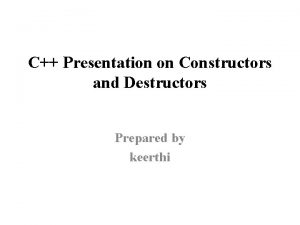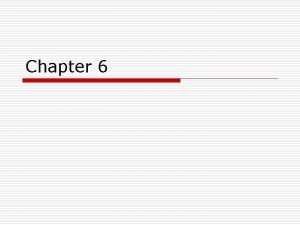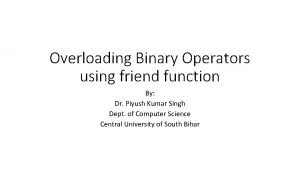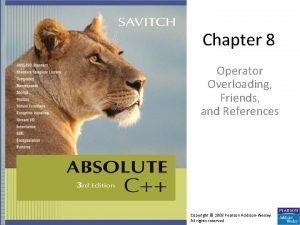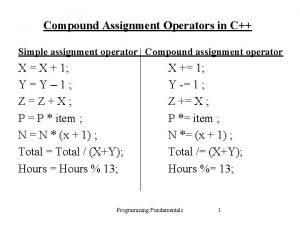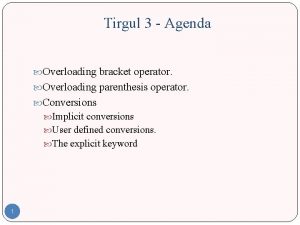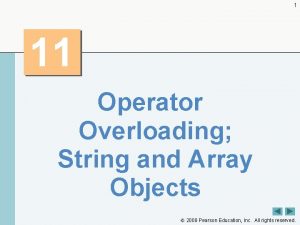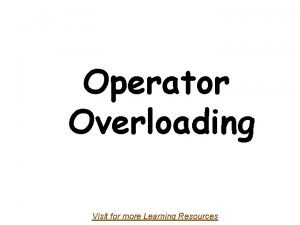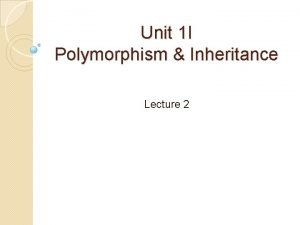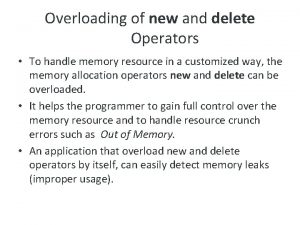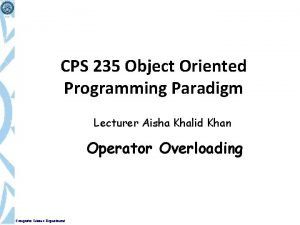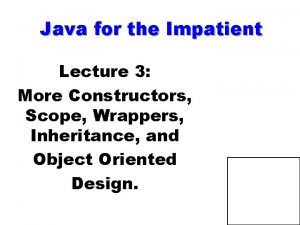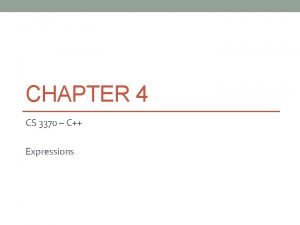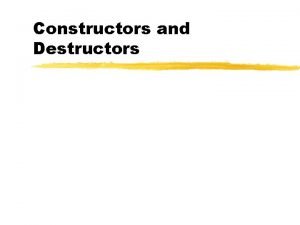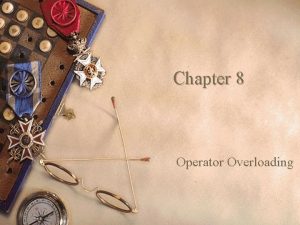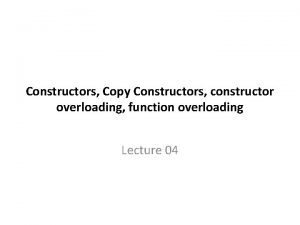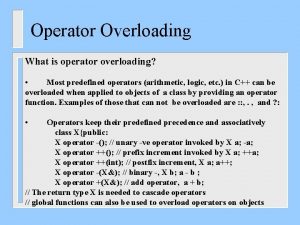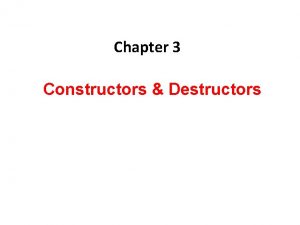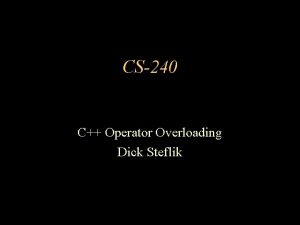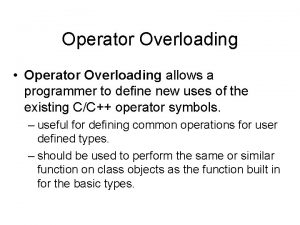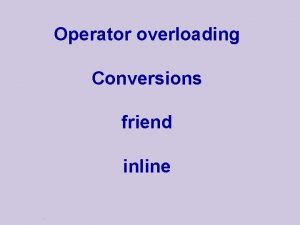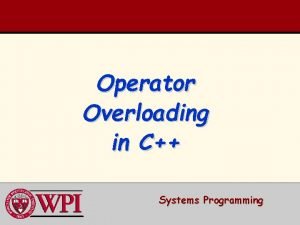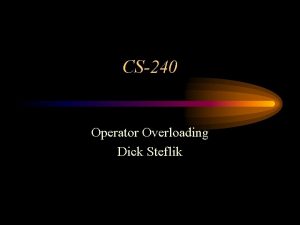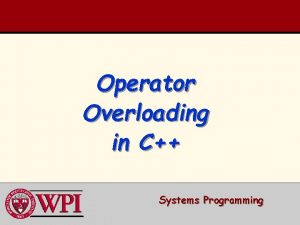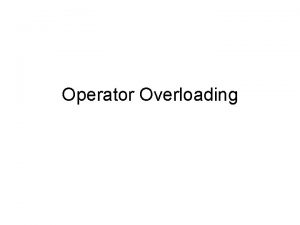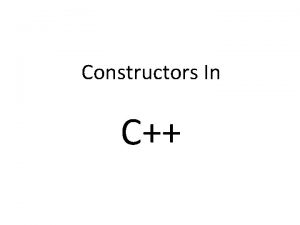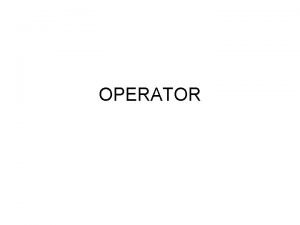Constructors Destructors Controlling initialization destruction Operator Overloading Most


















- Slides: 18

Constructors & Destructors Controlling initialization & destruction

Operator Overloading • Most operators in C++ can be overloaded • Two ways: • Member function of user defined class • Non-member "stand alone" function • Any operator overloading has to involve a user -defined class object • Has to be at least one operand that is not built-in • Most operators are binary (i. e. the have a left and a right-hand side), and the expression

Operator Overloading • x op y can be defined either • Stand-alone function call • operatorop(x, y); • Member-function call for x: • x. operatorop(y); • If define overloaded operator as member function, it must be member function of left -hand-side object

Interface & Implementation • We want to limit access to data members • Done with private keyword • We want to separate interface from implementation • Constructors automatically called when new object created • Destructors automatically called when object destroyed

Creation • Objects are created in a few ways • double x; • Creates an object of type double • C++ provides mechanism to control what happens when user defined classes are created in statement like above • Constructor

Constructors • Same name as class • No return type (not even void!) • Can be overloaded • Same name, differ by arguments they take • One with no arguments is “default” constructor

Example int main() { To. D x, y; return 0; } class To. D { private: int h, m; bool PM; public: To. D(){ cout << "To. D object created!" << endl; } }; What’s on the screen when the program runs?

Use? (besides cheesy messages) • Initialization • Sometimes objects need to have values or perform some operation before they can be used

Isolating Implementation • User can’t manipulate values • User doesn’t need to do anything to initialize • User can’t put object in invalid state

Destructors • • Only one per class Class name with ~ in front Doesn’t take any arguments Controls what happens when object destroyed • Called automatically

Destructor Example class Silly { private: string name; public: Silly(){ cout <<"A silly object is born!"<< endl; } ~Silly(){ cout <<"Silly object "<<name<<" dies!"<< endl; } }; int main() { Silly *p; if (1>0){ Silly first; first. name = “Tom"; p = new Silly[2]; p[0]. name = "John"; p[1]. name = “Sara"; } Silly last; last. name = “Tom Jr"; delete [] p; return 0; }

Use? • When is destructor useful? • Executed when object destroyed • Can do anything, but interesting when deallocate memory • Want to delete items created using new to free up memory

Destructor Example /** DEFINITION OF CLASS NODE **/ class Node { public: int data; Node *next; Node(int val, Node* p) { data = val; next = p; } }; List: : ~List() { while(head != 0) { Node *p = head; head = head->next; delete p; } }

Letting the User Define • What about letting the user choose initialization values? • Example: Point A. x = A. y = B. x = B. y = C. x = C. y = A, B, C; 2. 4; -0. 5; 0. 0; 3. 3; (A. x + B. x)/2; (A. y + B. y)/2;

Wouldn’t It Be Nice? Point A(2. 4, -0. 5), B(0. 0, 3. 3); Point C((A. x + B. x)/2, (A. y + B. y)/2); • Constructors make this possible

To the point (class) Class Point { public: double x, y; Point() { x = y = 0; } Point(double a) { x = a; y = 0; } Point(double a, double b) { x = a; y = b; } };

Calling Constructors • Called three ways 1. Previously mentioned • ex. Point p; 2. Using new Operator • ex. Point *p = new Point(3. 3, 7. 1); 3. As function that returns object • Point(3. 3, 7. 1). magnitude(); Class Point { public: double x, y; Point(double a, double b) { x = a; y = b; } double magnitude() { return sqrt(x*x + y*y); } };

Default Arguments • In any function prototype, can follow name of parameter with default value Class Point { public: double x, y; Point(double a = 0, double b = 0) { x = a; y = b; } };
 What is constructor
What is constructor Overloading methods and constructors in java
Overloading methods and constructors in java Binary operator overloading using friend function
Binary operator overloading using friend function Unary operator overloading
Unary operator overloading Simple assignment operators
Simple assignment operators C++ overload parenthesis operator
C++ overload parenthesis operator Operators overloaded for string objects
Operators overloaded for string objects Overload stream insertion operator c++ template
Overload stream insertion operator c++ template Unary operator overloading
Unary operator overloading Pitfalls of operator overloading in c++
Pitfalls of operator overloading in c++ New and delete operators can be overloaded
New and delete operators can be overloaded Binary operator overloading in c++
Binary operator overloading in c++ Destruction operator
Destruction operator Considerate constructors scoring matrix
Considerate constructors scoring matrix Constructor
Constructor Considerate constructors best practice hub
Considerate constructors best practice hub Pada tipe data boolean, berlaku operator-operator...
Pada tipe data boolean, berlaku operator-operator... Logical operators priority in c
Logical operators priority in c Binary and unary operators
Binary and unary operators
